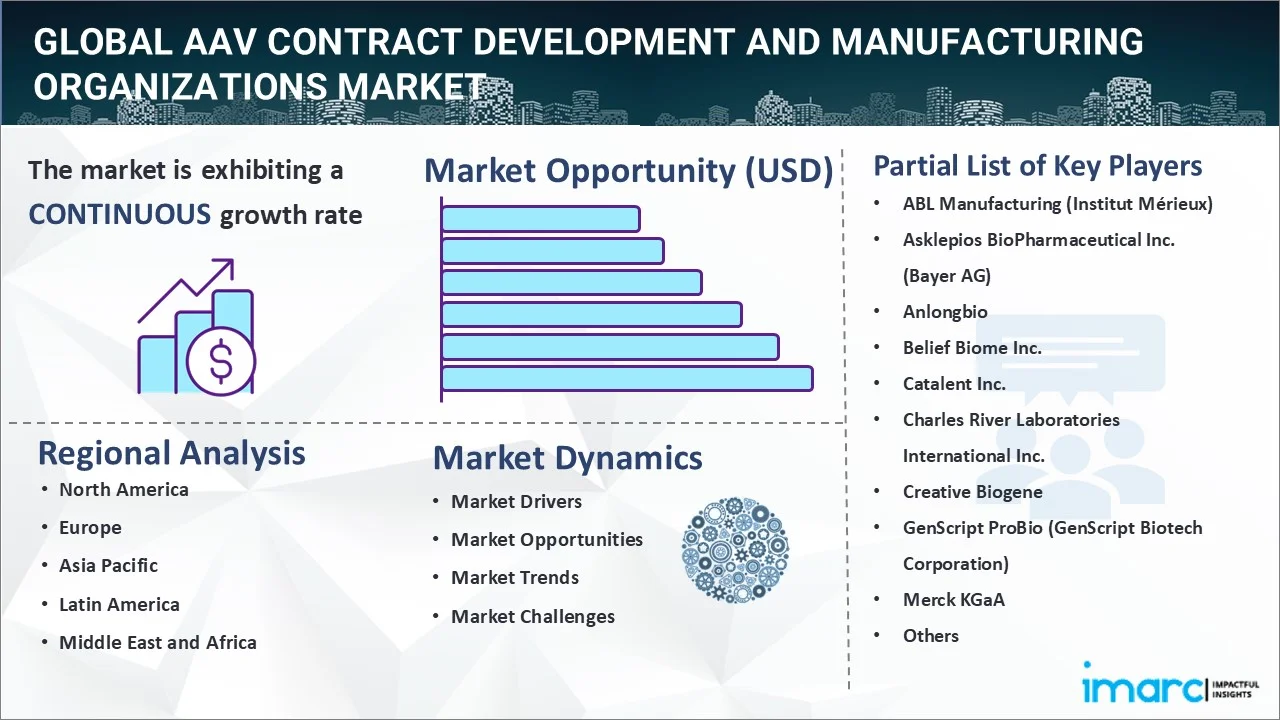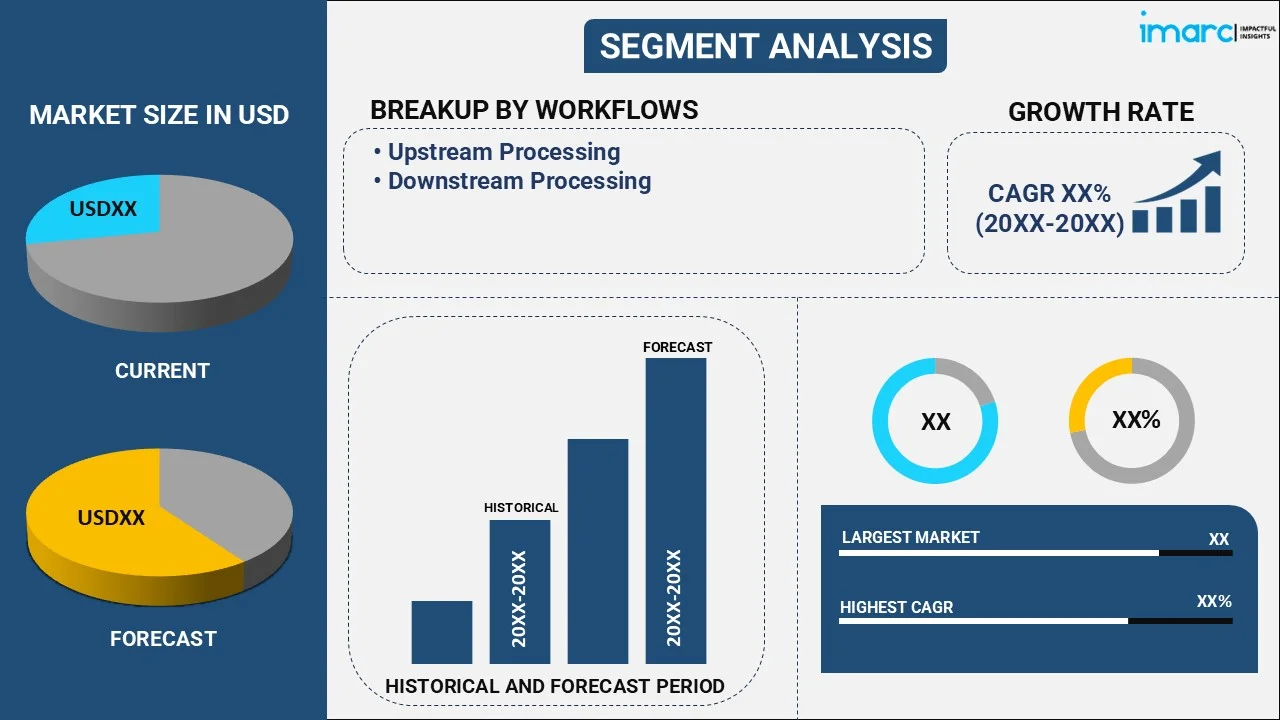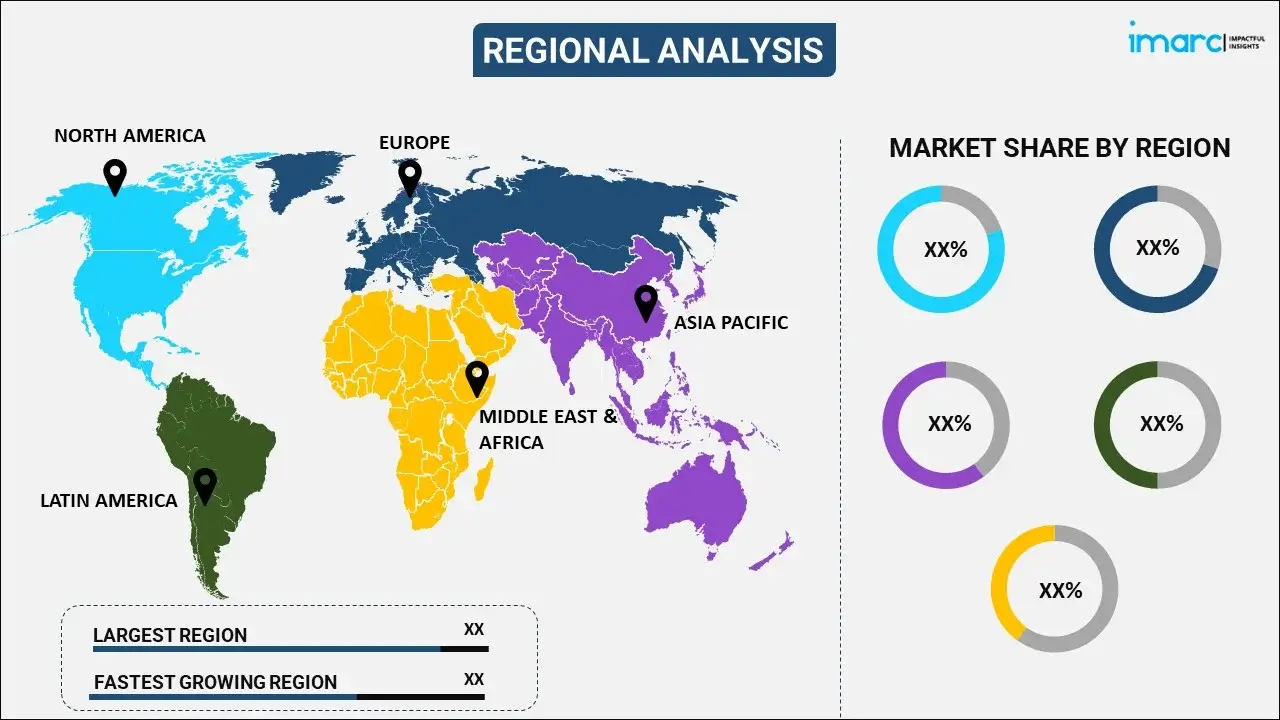
AAV Contract Development and Manufacturing Organizations Market Report by Workflow (Upstream Processing, Downstream Processing), Culture Type (Adherent Culture, Suspension Culture), Application (Cell and Gene Therapy Development, Vaccine Development, Biopharmaceutical and Pharmaceutical Discovery, Biomedical Research), End User (Pharmaceutical and Biopharmaceutical Companies, Academic and Research Institutes), and Region 2025-2033
Market Overview:
The global AAV contract development and manufacturing organizations market size reached USD 780.8 Million in 2024. Looking forward, IMARC Group expects the market to reach USD 2,891.8 Million by 2033, exhibiting a growth rate (CAGR) of 14.09% during 2025-2033. The growing prevalence of genetic disorders and rare diseases, rising advancements in gene therapy to treat various diseases with efficiency, and increasing number of approval processes for gene therapies are some of the major factors propelling the market.
|
Report Attribute
|
Key Statistics |
|---|---|
|
Base Year
|
2024 |
|
Forecast Years
|
2025-2033
|
|
Historical Years
|
2019-2024
|
| Market Size in 2024 | USD 780.8 Million |
| Market Forecast in 2033 | USD 2,891.8 Million |
| Market Growth Rate (2025-2033) | 14.09% |
Adeno-associated viruses (AAV) contract development and manufacturing organizations (CDMOs) are specialized firms that provide comprehensive services for the development, production, and manufacturing of AAV therapies. They possess the expertise to support clients through the entire product lifecycle, from initial research and development (R&D) to clinical trials and commercial production. They serve process development, analytical testing, regulatory support, and scalable manufacturing that are aligned with stringent quality standards and regulatory requirements. They play an essential role in accelerating the translation of promising gene therapies from concept to reality.

At present, the increasing preference for personalized medicine and patient-centric healthcare approach to enhance treatment efficacy and patient outcomes is impelling the growth of the market. Additionally, the rising adoption of AAV-based therapies that are used in gene therapy treatments is bolstering the growth of the market. In line with this, the increasing adoption of AAV-based therapies in clinical trials around the world is offering lucrative growth opportunities to industry investors. Apart from this, rapid advancements in bioprocessing technologies, analytics, and automation to optimize production processes, reduce costs, and enhance product quality are positively influencing the market. Moreover, the growing acceptance and recognition of gene therapies among the masses across the globe is offering a positive market outlook. Furthermore, the rising commercialization of gene therapies across the globe is supporting the growth of the market.
AAV Contract Development And Manufacturing Organizations Market Trends/Drivers:
Rising advancements in gene therapy
The rising demand for AAV CDMOs due to the increasing progress in gene therapy is contributing to the growth of the market. Gene therapies are emerging as a transformative approach for treating various diseases. Besides this, various pharmaceutical companies require specialized partners to efficiently develop and manufacture AAV-based therapies. AAV CDMOs offer critical expertise in process development, analytics, and manufacturing and ensure that gene therapies are produced reliably and consistently. Gene therapy also assists in addressing previously incurable genetic and acquired diseases by introducing corrected genetic material. Moreover, increasing advancements in gene editing tools, such as CRISPR-Cas9, allow the development of targeted and precise therapies.
Increasing prevalence of genetic disorders
The increasing prevalence of genetic disorders and rare diseases is bolstering the growth of the market. Genetic disorders comprise a wide range of conditions, such as stemming from genetic mutations, that adversely affect normal cellular functions. In addition, the growing need for innovative therapeutic interventions that assist in rectifying these genetic anomalies is offering a favorable market outlook. Apart from this, AAV-based therapies address previously untreatable conditions, which makes them a crucial point of research and development (R&D). In addition, AAV CDMOs provide the necessary infrastructure to manufacture these therapies at a large scale and allow pharmaceutical companies to meet the growing demand for treatments tailored to specific genetic conditions.
Rising number of approval processes for gene therapies
There is a rise in the number of approval processes for gene therapies that encourage pharmaceutical companies to partner with AAV CDMOs. Developing gene therapies involves navigating complex regulatory requirements, and AAV CDMOs have the experience and knowledge to ensure compliance. Their expertise assists in streamlining the path to regulatory approval and enables faster development timelines and commercialization. In addition, the collaborations between AAV CDMOs and pharmaceutical companies offer a strategic advantage to navigate these challenges effectively and efficiently. Moreover, AAV CDMOs benefit in the seamless transition of AAV-based therapies from preclinical stages to clinical trials and eventual market entry and maintain compliance and regulatory adherence, which is offering a positive market outlook.
AAV Contract Development And Manufacturing Organizations Industry Segmentation:
IMARC Group provides an analysis of the key trends in each segment of the global AAV contract development and manufacturing organizations market report, along with forecasts at the global, regional, and country levels from 2025-2033. Our report has categorized the market based on workflow, culture type, application, and end user.
Breakup by Workflow:

- Upstream Processing
- Downstream Processing
Downstream processing represents the largest market segment
The report has provided a detailed breakup and analysis of the market based on the workflow. This includes upstream processing and downstream processing. According to the report, downstream processing represented the largest segment. The downstream processing segment covers the purification and isolation of AAV vectors from the cell culture. This phase involves various steps, such as filtration, chromatography, and viral vector concentration. In line with this, AAV CDMOs specializing in downstream processing employ advanced purification technologies to achieve high product purity, yield, and quality. Furthermore, it assists in ensuring that the final product meets stringent regulatory standards and is suitable for clinical use.
Upstream processing involves the initial stages of AAV production, such as cell line development, vector design, and cell culture optimization. AAV CDMOs specializing in upstream processing collaborate with clients to create efficient and high-yield production systems. Apart from this, they focus on generating optimal viral vectors and ensuring enhanced production platforms, which are essential for the further stages of manufacturing.
Breakup by Culture Type:
- Adherent Culture
- Suspension Culture
Adherent culture accounts for the majority of the market share
The report has provided a detailed breakup and analysis of the market based on the culture type. This includes adherent culture and suspension culture. According to the report, adherent culture represented the largest segment. In adherent culture, cells are attached to a surface, such as the walls of a culture vessel or a microcarrier. This method is commonly used for adherent cells that require a surface for growth and support. In addition, AAV CDMOs specializing in adherent culture develop optimized processes for cell attachment, growth, and viral vector production. Apart from this, they ensure the provision of suitable growth conditions and scalable systems to maintain cell viability and productivity.
Suspension culture involves growing cells in a liquid medium without the need for attachment to surfaces. This method is well-suited for cells that naturally grow in suspension or for processes requiring large-scale production. AAV CDMOs focus on suspension culture design and implement bioreactor-based systems to facilitate efficient cell growth, vector production, and scalability. They ensure proper nutrient supply, aeration, and agitation to maintain cell health and maximize AAV yield.
Breakup by Application:
- Cell and Gene Therapy Development
- Vaccine Development
- Biopharmaceutical and Pharmaceutical Discovery
- Biomedical Research
Cell and gene therapy development holds the biggest market share
The report has provided a detailed breakup and analysis of the market based on the application. This includes cell and gene therapy development, vaccine development, biopharmaceutical and pharmaceutical discovery, and biomedical research. According to the report, cell and gene therapy development represented the largest segment. AAV CDMOs specializing in the cell and gene therapy development segment collaborate with pharmaceutical companies and research institutions to develop and manufacture AAV-based therapies for the treatment of various genetic and acquired diseases. These therapies leverage the potential of AAV vectors to deliver genetic material into cells and offer a promising avenue for personalized and targeted treatments.
Moreover, AAV CDMOs in the vaccine development category contribute to the creation of novel vaccines by utilizing AAV vectors to deliver antigens or genetic material that stimulate immune responses. This approach holds potential for developing effective vaccines against infectious diseases and cancers and opens new avenues for preventive medicine.
In the biopharmaceutical and pharmaceutical discovery segment, AAV vectors are employed as valuable tools for drug discovery and development. AAV CDMOs collaborate with researchers and pharmaceutical companies to design and produce AAV vectors used in preclinical studies, target validation, and drug delivery research.
Breakup by End User:
- Pharmaceutical and Biopharmaceutical Companies
- Academic and Research Institutes
Pharmaceutical and biopharmaceutical companies dominate the market share
The report has provided a detailed breakup and analysis of the market based on the end user. This includes pharmaceutical and biopharmaceutical companies and academic and research institutes. According to the report, pharmaceutical and biopharmaceutical companies represented the largest segment. Pharmaceutical and biopharmaceutical companies are engaging in partnership with AAV CDMOs to outsource specialized tasks related to AAV therapy development and manufacturing. AAV CDMOs provide the required infrastructure, knowledge, and resources to improve the production of AAV-based therapies and enable pharmaceutical and biopharmaceutical companies to focus on their core competencies and bring innovative treatments to market.
Another significant segment involves collaborations between AAV CDMOs and academic and research institutes. These institutions often lack the extensive manufacturing capabilities required for AAV-based therapy development. AAV CDMOs offer their expertise to assist researchers in translating their discoveries into viable treatments. By outsourcing manufacturing tasks, academic and research institutes can efficiently move their experimental therapies through preclinical and clinical development stages.
Breakup by Region:

- North America
- United States
- Canada
- Europe
- Germany
- France
- United Kingdom
- Italy
- Spain
- Others
- Asia Pacific
- China
- Japan
- India
- South Korea
- Australia
- Indonesia
- Others
- Latin America
- Brazil
- Mexico
- Others
- Middle East and Africa
North America exhibits a clear dominance, accounting for the largest AAV contract development and manufacturing organizations market share
The report has also provided a comprehensive analysis of all the major regional markets, which include North America (the United States and Canada); Europe (Germany, France, the United Kingdom, Italy, Spain, and others); Asia Pacific (China, Japan, India, South Korea, Australia, Indonesia, and others); Latin America (Brazil, Mexico, and others); and the Middle East and Africa. According to the report, North America accounted for the largest market share.
North America held the biggest market share due to the strong presence of biopharmaceutical and biotechnology companies. Apart from this, the rising adoption of AVV CDMOs due to the favorable regulatory framework is contributing to the growth of the market in the region. In line with this, the increasing number of approvals for AVV therapies is supporting the growth of the market. Additionally, rising advancements in gene therapies is bolstering the growth of the market in the region.
Competitive Landscape:
Major players are primarily providing specialized services throughout the entire lifecycle of AAV-based therapy development and manufacturing. They are collaborating with clients to design and optimize production processes for AAV vectors. This involves selecting suitable cell lines, developing scalable and efficient bioprocessing techniques, and ensuring robust and reproducible methods. Apart from this, key players are undertaking large-scale production of AAV vectors using advanced bioreactor systems. They ensure adherence to good manufacturing practices (GMP) and enhanced quality control standards to produce AAV vectors suitable for clinical trials and commercial use. In line with this, companies are performing comprehensive analytical testing to verify the quality and consistency of the produced vectors.
The report has provided a comprehensive analysis of the competitive landscape in the market. Detailed profiles of all major companies have also been provided. Some of the key players in the market include:
- ABL Manufacturing (Institut Mérieux)
- Asklepios BioPharmaceutical Inc. (Bayer AG)
- Anlongbio
- Belief Biome Inc.
- Catalent Inc.
- Charles River Laboratories International Inc.
- Creative Biogene
- GenScript ProBio (GenScript Biotech Corporation)
- Merck KGaA
- Oxford Biomedica
- TFBS Bioscience Inc.
- Thermo Fischer Scientific Inc.
AAV Contract Development And Manufacturing Organizations Market Report Scope:
| Report Features | Details |
|---|---|
| Base Year of the Analysis | 2024 |
| Historical Period | 2019-2024 |
| Forecast Period | 2025-2033 |
| Units | Million USD |
| Scope of the Report | Exploration of Historical and Forecast Trends, Industry Catalysts and Challenges, Segment-Wise Historical and Predictive Market Assessment:
|
| Workflows Covered | Upstream Processing, Downstream Processing |
| Culture Types Covered | Adherent Culture, Suspension Culture |
| Applications Covered | Cell and Gene Therapy Development, Vaccine Development, Biopharmaceutical and Pharmaceutical Discovery, Biomedical Research |
| End Users Covered | Pharmaceutical and Biopharmaceutical Companies, Academic and Research Institutes |
| Regions Covered | Asia Pacific, Europe, North America, Latin America, Middle East and Africa |
| Countries Covered | United States, Canada, Germany, France, United Kingdom, Italy, Spain, China, Japan, India, South Korea, Australia, Indonesia, Brazil, Mexico |
| Companies Covered | ABL Manufacturing (Institut Mérieux), Asklepios BioPharmaceutical Inc. (Bayer AG), Anlongbio, Belief Biome Inc., Catalent Inc., Charles River Laboratories International Inc., Creative Biogene, GenScript ProBio (GenScript Biotech Corporation), Merck KGaA, Oxford Biomedica, TFBS Bioscience Inc., Thermo Fischer Scientific Inc., etc. |
| Customization Scope | 10% Free Customization |
| Post-Sale Analyst Support | 10-12 Weeks |
| Delivery Format | PDF and Excel through Email (We can also provide the editable version of the report in PPT/Word format on special request) |
Key Questions Answered in This Report:
- How has the global AAV contract development and manufacturing organizations market performed so far, and how will it perform in the coming years?
- What are the drivers, restraints, and opportunities in the global AAV contract development and manufacturing organizations market?
- What is the impact of each driver, restraint, and opportunity on the global AAV contract development and manufacturing organizations market?
- What are the key regional markets?
- Which countries represent the most attractive AAV contract development and manufacturing organizations market?
- What is the breakup of the market based on the workflow?
- Which is the most attractive workflow in the AAV contract development and manufacturing organizations market?
- What is the breakup of the market based on the culture type?
- Which is the most attractive culture type in the AAV contract development and manufacturing organizations market?
- What is the breakup of the market based on the application?
- Which is the most attractive application in the AAV contract development and manufacturing organizations market?
- What is the breakup of the market based on the end user?
- Which is the most attractive end user in the AAV contract development and manufacturing organizations market?
- What is the competitive structure of the global AAV contract development and manufacturing organizations market?
- Who are the key players/companies in the global AAV contract development and manufacturing organizations market?
Key Benefits for Stakeholders:
- IMARC’s report offers a comprehensive quantitative analysis of various market segments, historical and current market trends, market forecasts, and dynamics of the AAV contract development and manufacturing organizations market from 2019-2033.
- The research study provides the latest information on the market drivers, challenges, and opportunities in the global AAV contract development and manufacturing organizations market.
- The study maps the leading, as well as the fastest-growing, regional markets. It further enables stakeholders to identify the key country-level markets within each region.
- Porter's five forces analysis assist stakeholders in assessing the impact of new entrants, competitive rivalry, supplier power, buyer power, and the threat of substitution. It helps stakeholders to analyze the level of competition within the AAV contract development and manufacturing organizations industry and its attractiveness.
- Competitive landscape allows stakeholders to understand their competitive environment and provides an insight into the current positions of key players in the market.
Need more help?
- Speak to our experienced analysts for insights on the current market scenarios.
- Include additional segments and countries to customize the report as per your requirement.
- Gain an unparalleled competitive advantage in your domain by understanding how to utilize the report and positively impacting your operations and revenue.
- For further assistance, please connect with our analysts.
 Request Customization
Request Customization
 Speak to an Analyst
Speak to an Analyst
 Request Brochure
Request Brochure
 Inquire Before Buying
Inquire Before Buying




.webp)




.webp)












